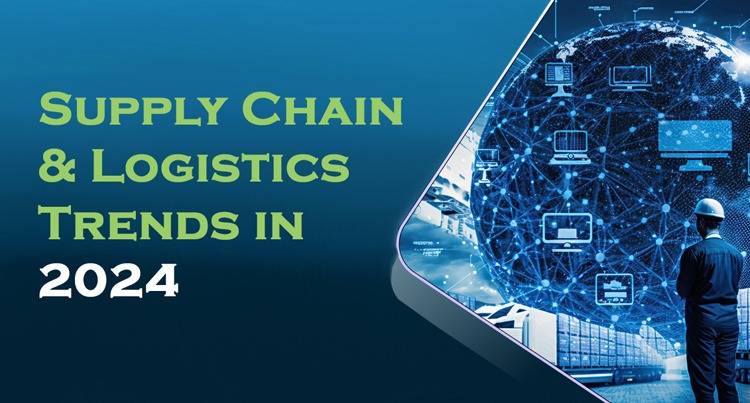2025 Trends in the Logistics Industry
The logistics and supply chain industry is set to experience dynamic growth in 2025, driven by global investments and efforts to enhance resilience and sustainability. Key highlights include:
Global Economic Boost:
- Increased investments in U.S. manufacturing by global players will spark a surge in activity, especially in industrial sectors.
- Expansion of ocean freight capacity and upgrades to port infrastructure are critical priorities, especially following the impact of last year’s Longshoreman strike.
Industry Imports and Exports:
- Growth in inbound imports will support domestic manufacturing.
- Accelerated development of U.S.-based chip manufacturing plants will reduce dependency on foreign suppliers and diversify the global chip supply chain.
- An increase in agricultural exports, balanced by imports of foreign goods, is anticipated, influenced by tariff threats.
Vertical Market Growth:
- Strong activity in medical equipment manufacturing will continue, driven by technological innovation.
- Integration of AI across industries will enhance efficiency and customer-vendor relationships.
- A stronger focus on quality compliance will emerge as a key differentiator.
Environmental Sustainability:
- Efforts to reduce emissions and develop solar and nuclear energy sources will remain a priority.
- Economic viability and long-term strategies will guide environmental initiatives without imposing strict mandates.
For Technical Transportation in 2025, the company expects to see additional growth in the medical equipment and cash automation markets, while the opportunity to explore new verticals will increase. In addition, the company year will focus on continued improvements in internal processes to drive efficiency, quality and growth.
The company also expects to receive its ISO certification by February, which will reinforce TechTrans’ commitment to quality while expanding opportunities with both existing and new customers.
These trends highlight an optimistic and transformative year for the logistics industry, characterized by innovation, sustainability, and growth across key sectors.
Navigating the Supply Chain in 2024: Trends and Adaptations
As 2024 continues to unfold, the echoes of a strong 2023 finish still reverberate in some sectors of the supply chain, shaping trends for the year ahead. In this blog, we’ll discuss some of those trends and what will impact the industry in 2024.
Healthy Healthcare Sector
The healthcare and medical field showed resilience as it marked phenomenal growth during the last quarter of 2023. This momentum is expected to carry forward into 2024, propelled by the strengthening of hospital groups and the emergence of new healthcare facilities.
Mergers within the medical sector will further strengthen key players, while investments in smart technology drive the replacement of obsolete equipment in life sciences, promising greater efficiency and reliability.
Building Quality Assurance
Quality Assurance (QA) remains a key focus in logistics, with companies placing a premium on stringent processes. During the past couple of years, TechTrans has underscored a commitment to excellence, and we continue to grow a dedicated QA organization with our own internal talent.
This commitment to QA, combined with enhanced data analytics, helps us better track and trace trends that provide invaluable insights for informed decision-making and improved client services. We believe this commitment to QA will continue to enhance our growth in 2024 to be considered ”Best in Class” among supply chain providers.
Life Sciences Growing Organically
In the realm of life sciences specifically, advancements in automation are reshaping processes, from inventory management to prescription dispensing. The integration of self-enclosed, self-dispensing machines brings forth a new era of efficiency and accuracy, reducing reliance on human intervention and mitigating potential errors.
This trend towards automation presents opportunities for logistics companies to establish a larger presence in the market, capitalizing on the demand for streamlined supply chain solutions.
Geopolitical and Economic Mess Ahead?
Despite global uncertainties, including geopolitical tensions and fluctuating oil prices, the supply chain remains resilient. Tariffs have yet to significantly disrupt operations, while developments in chip manufacturing plants, particularly in regions like Texas, offer new avenues for growth. In addition, unemployment remains low, however, the specter of inflation looms large and poses challenges for cost management and pricing strategies in the months ahead.
Automotive Crossroads
The automotive industry finds itself at a crossroads as it grapples with the transition to electric vehicles (EVs) amidst infrastructure challenges. While the EV market continues to expand, consumer adoption remains tempered by concerns over technology readiness and charging infrastructure. Meanwhile, geopolitical tensions in regions such as Ukraine and Gaza exert pressure on oil prices, influencing consumer behavior and spending patterns.
Consumer Caution Signs
In the face of economic uncertainty, consumers are exercising caution, prioritizing essential purchases and reevaluating spending habits. The rising costs of utilities and fuel are prompting individuals to adopt more conservative approaches, with travel and ancillary spending experiencing a downturn.
Concurrently, demographic shifts are reshaping the workforce landscape, with advancements in healthcare enabling individuals to work longer, fostering a more sustainable and inclusive workforce.
As we navigate the complexities of the supply chain in 2024, adaptability and innovation will be important. From embracing automation to leveraging data analytics, logistics organizations must remain agile in the face of evolving market dynamics. By staying attuned to emerging trends and harnessing technological advancements, businesses can position themselves for success in this ever-changing landscape.



